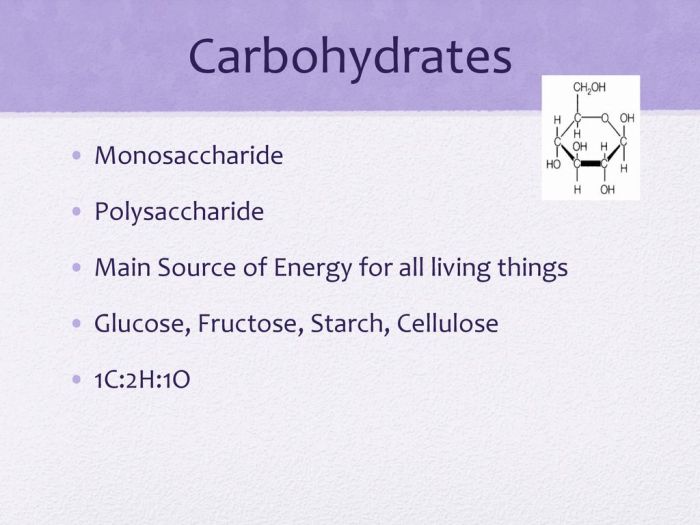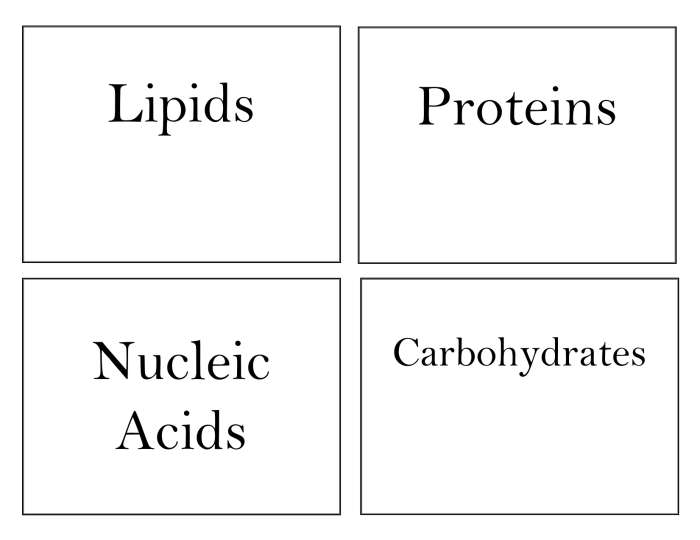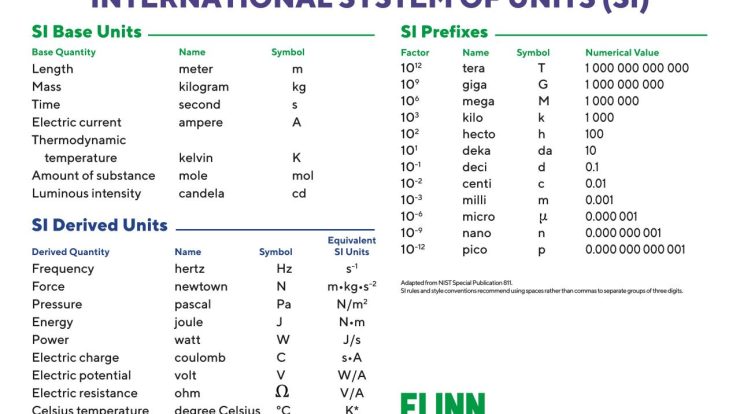The Macromolecules Card Sort Answer Key serves as an indispensable resource for educators seeking to evaluate their students’ understanding of macromolecules, the building blocks of life. This comprehensive answer key provides accurate solutions to the card sort activity, enabling teachers to assess student learning and identify areas for further instruction.
Through engaging and interactive card sorting exercises, students explore the diverse types of macromolecules, their structures, and their vital roles in living organisms. The answer key provides detailed explanations for each card, ensuring a thorough understanding of the concepts.
Macromolecules

Macromolecules are large molecules that play a crucial role in the structure and function of living organisms. They are composed of repeating subunits called monomers, which are linked together by covalent bonds.
Macromolecules are classified into four main types: carbohydrates, lipids, proteins, and nucleic acids. Each type has a unique structure and function, and they work together to maintain the life processes of cells and organisms.
Carbohydrates
Carbohydrates are composed of carbon, hydrogen, and oxygen atoms, and they are the primary source of energy for living organisms. They are classified into three main groups: monosaccharides, disaccharides, and polysaccharides.
- Monosaccharidesare the simplest carbohydrates and consist of a single sugar unit, such as glucose, fructose, and galactose.
- Disaccharidesare composed of two monosaccharides linked together, such as sucrose (glucose + fructose) and lactose (glucose + galactose).
- Polysaccharidesare complex carbohydrates composed of many monosaccharides linked together, such as starch, glycogen, and cellulose.
Lipids
Lipids are a diverse group of molecules that are insoluble in water. They include fats, oils, waxes, and steroids.
- Fatsare composed of glycerol and three fatty acids, and they are the primary energy storage molecules in animals.
- Oilsare similar to fats but are liquid at room temperature, and they are found in plants and fish.
- Waxesare composed of long-chain fatty acids and alcohols, and they are used to protect surfaces from water and abrasion.
- Steroidsare a group of lipids that include cholesterol, which is essential for the structure of cell membranes.
Proteins
Proteins are composed of amino acids, which are linked together by peptide bonds. They are essential for a wide range of cellular functions, including metabolism, growth, and repair.
- Enzymesare proteins that catalyze chemical reactions in cells, and they are essential for metabolism.
- Structural proteinsprovide support and shape to cells and tissues, such as collagen and keratin.
- Transport proteinsmove molecules across cell membranes, such as hemoglobin and ion channels.
- Hormonesare proteins that regulate various physiological processes, such as insulin and growth hormone.
Nucleic Acids, Macromolecules card sort answer key
Nucleic acids are composed of nucleotides, which are linked together by phosphodiester bonds. They store and transmit genetic information.
- DNA(deoxyribonucleic acid) is the genetic material of cells, and it contains the instructions for protein synthesis.
- RNA(ribonucleic acid) is involved in protein synthesis and other cellular processes, such as mRNA (messenger RNA), tRNA (transfer RNA), and rRNA (ribosomal RNA).
Card Sort Activity

A card sort activity is a valuable tool for educators to assess students’ understanding of complex concepts. It involves distributing cards with different terms, concepts, or ideas to students and asking them to group or categorize the cards based on their understanding of the topic.
In the context of macromolecules, a card sort activity can be used to evaluate students’ grasp of the different types of macromolecules, their structures, functions, and their roles in living organisms.
Steps for Conducting a Card Sort Activity
- Prepare the cards:Create a set of cards, each containing a different term, concept, or idea related to macromolecules. These could include terms such as “carbohydrate,” “protein,” “lipid,” “nucleic acid,” or specific examples of each type of macromolecule.
- Distribute the cards to students:Provide each student or group of students with a set of cards.
- Provide instructions:Explain the purpose of the activity and provide clear instructions on how to sort the cards. Encourage students to discuss and collaborate with each other.
- Observe and assess:As students work on the activity, observe their interactions and listen to their discussions. This will provide insights into their understanding of the concepts and their ability to apply their knowledge.
- Discuss and debrief:Once students have completed the activity, facilitate a class discussion to review the different categories and discuss the rationale behind the students’ choices. This allows for further clarification and reinforcement of the concepts.
Answer Key: Macromolecules Card Sort Answer Key

Carbohydrates
- Glucose:Monosaccharide with six carbon atoms, an aldehyde group, and a hydroxyl group on each carbon atom.
- Sucrose:Disaccharide composed of glucose and fructose.
- Starch:Polysaccharide composed of many glucose molecules linked together.
Lipids
- Triglyceride:Composed of three fatty acid chains attached to a glycerol molecule.
- Phospholipid:Composed of a glycerol molecule attached to two fatty acid chains and a phosphate group.
- Cholesterol:Steroid molecule found in cell membranes.
Proteins
- Amino acid:Building block of proteins, consisting of an amino group, a carboxyl group, and a side chain.
- Polypeptide:Chain of amino acids linked together by peptide bonds.
- Enzyme:Protein that catalyzes a chemical reaction.
Nucleic Acids, Macromolecules card sort answer key
- Nucleotide:Composed of a nitrogenous base, a ribose or deoxyribose sugar, and a phosphate group.
- DNA:Double-stranded molecule that carries genetic information.
- RNA:Single-stranded molecule that plays various roles in protein synthesis and gene regulation.
Top FAQs
What is the purpose of a card sort activity in macromolecule education?
Card sort activities provide a hands-on, interactive approach to assessing students’ understanding of macromolecules. By sorting cards with information about different macromolecules, students can demonstrate their ability to identify, classify, and compare these essential biological components.
How can the Macromolecules Card Sort Answer Key help educators?
The answer key provides educators with accurate solutions to the card sort activity, allowing them to quickly and efficiently assess student learning. By comparing student responses to the answer key, teachers can identify areas where students have a strong understanding and areas where further instruction is needed.
What are the benefits of using the Macromolecules Card Sort Activity and Answer Key in the classroom?
This activity and answer key offer numerous benefits for students and educators. For students, it provides an engaging and interactive way to learn about macromolecules, while also developing their critical thinking and problem-solving skills. For educators, it provides a valuable assessment tool that can be used to tailor instruction to meet the needs of their students.
